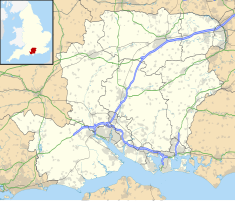| The Vyne | |
|---|---|
 The north front | |
| Type | Country House |
| Location | Sherborne St John |
| Coordinates | 51°18′25″N 01°05′19″W / 51.30694°N 1.08861°W |
| OS grid reference | SU 63627 56816 |
| Area | Hampshire |
| Built | 1500–1520 |
| Rebuilt | 17th, 18th and 19th centuries |
| Architect | John Webb |
| Owner | National Trust |
Listed Building – Grade I | |
| Official name | The Vyne |
| Designated | 26 April 1957 |
| Reference no. | 1296972 |
The Vyne is a Grade I listed[1] 16th-century country house in the parish of Sherborne St John, near Basingstoke, in Hampshire, England. The house was first built circa 1500–10 in the Tudor style by William Sandys, 1st Baron Sandys, Lord Chamberlain to King Henry VIII. In the 17th century it was transformed to resemble a classical mansion. Today, although much reduced in size, the house retains its Tudor chapel, with contemporary stained glass. The classical portico on the north front was added in 1654 to the design of John Webb, a pupil of Inigo Jones, and is notable as the first portico in English domestic architecture.
In the mid-18th century the house belonged to John Chaloner Chute, a close friend of the architectural pioneer Horace Walpole, who designed the principal stair hall containing an imperial staircase the grand scale of which belies its true small size. In 1958 The Vyne was bequeathed by Charles Chute to the National Trust.
- ^ Historic England (26 April 1957). "The Vyne (Grade I) (1296972)". National Heritage List for England.
